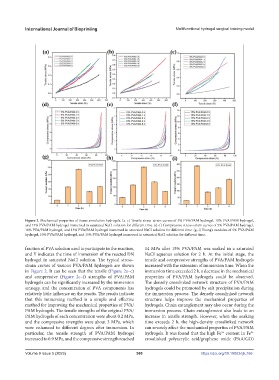Page 368 - IJB-9-5
P. 368
International Journal of Bioprinting Multifunctional hydrogel surgical training model
Figure 2. Mechanical properties of tissue simulation hydrogels. (a–c) Tensile stress–strain curves of 5% PVA/PAM hydrogel, 10% PVA/PAM hydrogel,
and 15% PVA/PAM hydrogel immersed in saturated NaCl solution for different time. (d–f) Compressive stress–strain curves of 5% PVA/PAM hydrogel,
10% PVA/PAM hydrogel, and 15% PVA/PAM hydrogel immersed in saturated NaCl solution for different time. (g–i) Young’s modulus of 5% PVA/PAM
hydrogel, 10% PVA/PAM hydrogel, and 15% PVA/PAM hydrogel immersed in saturated NaCl solution for different time.
fraction of PVA solution used to participate in the reaction, 14 MPa after 15% PVA/PAM was soaked in a saturated
and Y indicates the time of immersion of the reacted DN NaCl aqueous solution for 2 h. At the initial stage, the
hydrogel in saturated NaCl solution. The typical stress– tensile and compressive strengths of PVA/PAM hydrogels
strain curves of various PVA/PAM hydrogels are shown increased with the extension of immersion time. When the
in Figure 2. It can be seen that the tensile (Figure 2a–c) immersion time exceeded 2 h, a decrease in the mechanical
and compressive (Figure 2c–f) strengths of PVA/PAM properties of PVA/PAM hydrogels could be observed.
hydrogels can be significantly increased by the immersion The densely crosslinked network structure of PVA/PAM
strategy, and the concentration of PVA components has hydrogels could be promoted by salt precipitation during
relatively little influence on the results. The results indicate the immersion process. The densely crosslinked network
that this immersing method is a simple and effective structure helps improve the mechanical properties of
method for improving the mechanical properties of PVA/ hydrogels. Chain entanglement may also occur during the
PAM hydrogels. The tensile strengths of the original PVA/ immersion process. Chain entanglement also leads to an
PAM hydrogels of each concentration were about 0.2 MPa, increase in tensile strength. However, when the soaking
and the compressive strengths were about 3 MPa, which time exceeds 2 h, the high-density crosslinked network
were enhanced to different degrees after immersion. In can severely affect the mechanical properties of PVA/PAM
particular, the tensile strength of PVA/PAM hydrogel hydrogels. It was found that the high Fe content in Fe
3+
3+
increased to 0.9 MPa, and the compressive strength reached crosslinked polyacrylic acid/graphene oxide (PAA/GO)
Volume 9 Issue 5 (2023) 360 https://doi.org/10.18063/ijb.766

